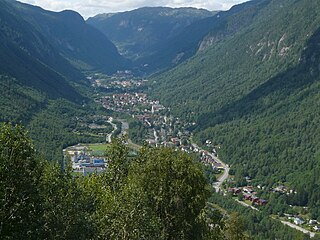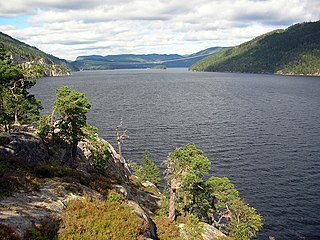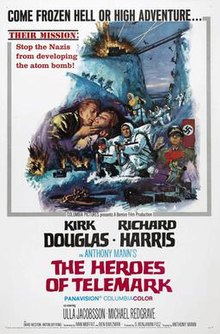
The Norwegian resistance to the occupation of Norway by Nazi Germany began after Operation Weserübung in 1940 and ended in 1945. It took several forms:

Tinn is a municipality in Vestfold og Telemark county, Norway. It is located in the traditional districts of Aust-Telemark and Upper Telemark. The administrative centre of the municipality is the town of Rjukan. Some of the villages in Tinn include Atrå, Austbygde, Hovin, and Miland.

The Norwegian heavy water sabotage was a series of Allied-led efforts to halt German heavy water production via hydroelectric plants in Nazi Germany-occupied Norway during World War II, involving both Norwegian commandos and Allied bombing raids. During the war, the Allies sought to inhibit the German development of nuclear weapons with the removal of heavy water and the destruction of heavy-water production plants. The Norwegian heavy water sabotage was aimed at the 60 MW Vemork power station at the Rjukan waterfall in Telemark.

Gunnar Fridtjof Thurmann Sønsteby DSO was a member of the Norwegian resistance movement during the German occupation of Norway in World War II. Known by the nickname "Kjakan" and as "Agent No. 24", he was the most highly decorated citizen in Norway, including being the only person to have been awarded the War Cross with three swords, Norway's highest military decoration.

Sigrid Gurie was an American actress from the late 1930s to early 1940s.

Tinnsjå is one of the largest lakes in Norway measuring about 51.38 km2 (19.84 sq mi). It is also one of the deepest lakes in Europe, reaching a depth of 460 m (1,510 ft). Tinnsjå is located in the municipalities of Tinn and Notodden in Vestfold og Telemark county. At its source in the west, the Måna river flows out of the lake Møsvatn and past the town of Rjukan into Tinnsjå. From the north, the river Mår flows from the lakes Mår, Gøystavatn, and Kalhovdfjorden into Tinnsjå. Tinnsjå is part of the Skien watershed, and it drains via the Tinnelva river in the south, down to the lake Heddalsvatn.

Knut Haukelid was a Norwegian military officer. He was a Norwegian resistance movement soldier during World War II, most notable for participating in the Norwegian heavy water sabotage.

Joachim Holmboe Rønneberg was a Norwegian Army officer and broadcaster. He was known for his resistance work during World War II, most notably commanding Operation Gunnerside, and his post-war war information work.

Knut Magne Haugland, DSO, MM, was a resistance fighter and noted explorer from Norway, who accompanied Thor Heyerdahl on his famous 1947 Kon-Tiki expedition.

SF Hydro was a Norwegian steam powered railway ferry that operated in the first half of the 20th century on Lake Tinn in Telemark. It connected with the Rjukan Line and Tinnoset Line, at Mæl and Tinnoset, operating between 1914 and 1944. The combined track and ferry service was primarily used to transport raw materials and fertilizer from Norsk Hydro's factory at Rjukan to the port in Skien. It was the target of a Norwegian operation on 20 February 1944, when resistance fighters sank the ferry in the deepest part of Lake Tinn to prevent Nazi Germany from receiving heavy water.

Ulla Jacobsson was a Swedish actress. She had the lead role in One Summer of Happiness (1951) and played the only female speaking role in the film Zulu (1964).
The Osvald Group was a Norwegian organisation that was the most active World War II resistance group in Norway from 1941 to the summer of 1944. Numbering more than 200 members, it committed at least 110 acts of sabotage against Nazi occupying forces and the collaborationist government of Vidkun Quisling. The organisation is perhaps best known for conducting the first act of resistance against the German occupation of Norway, when on 2 February 1942, it detonated a bomb at Oslo East Station in protest against Quisling's inauguration as Minister-President.
Arne Kjelstrup, MM was a Norwegian resistance member during World War II, especially noted for his role in the heavy water sabotage 1942–1943, and for being military leader of Milorg section D-161 (Kongsberg/Numedal) during the anti-demolition operation Sunshine 1944–1945.
The Lysaker Bridge sabotage was a sabotage action in World War II which occurred in Norway on the night between 13 and 14 April 1940 when a bridge at Lysaker, bordering Oslo, was blown up.
Knut Lier-Hansen was a Norwegian resistance member during World War II. He was born and grew up in Rjukan. Around 1940 he was a sergeant in the Norwegian Army, and tried to repel the German invaders in April 1940, among others in a skirmish at Gransherad. He later joined the more irregular resistance movement. His most notable mission was the sinking of SF Hydro as a part of the Norwegian heavy water sabotage. After placing explosives below deck in the ferry, the saboteurs had to wait until the ferry's departure in the morning to oversee that nothing went against the plan. After witnessing the ferry leave harbor in a normal way, Lier-Hansen fled the scene for Einar Skinnarland's house. The ferry went down in the middle of Lake Tinn, and in addition to sabotaging the heavy water program, eighteen lives were lost. When the war between Germany and Norway was over, on 8 May 1945, Lier-Hansen was dispatched together with Henry Johansen and another person to arrest Reichskommissar für die besetzten Norwegischen Gebiete Josef Terboven. The Norwegians reached Skaugum where Terboven had entrenched himself, but they were warded off by guards. Soon after, Terboven blew himself up.

Operation Swallow: The Battle for Heavy Water is a Norwegian-French film from 1948. The history is based on the best known commando raid in Norway during World War II, where the resistance group Norwegian Independent Company 1 destroyed the heavy water plant at Vemork in Telemark in February 1943.
The Heavy Water War is a six-episode war drama TV miniseries written by Petter S. Rosenlund and produced by Norwegian Broadcasting Corporation. It is a Norwegian/Danish/British co-production directed by Per-Olav Sørensen based on the true story of the German nuclear weapon project during the Second World War and the heavy water sabotage in Norway to disrupt it, with a particular emphasis on the role of the Norwegian intelligence officer Leif Tronstad.
Hans "Kyllingen" Storhaug, MM, DSM was a Norwegian resistance member during World War II, especially noted for his role in the heavy water sabotage 1942–1943, and for his participation in the SOE operation Grebe and Grebe Red in Østerdalen 1943–1945.
Vi vil leve is a Norwegian film from 1946 directed by Olav Dalgard and Rolf Randall. The film deals with the German occupation of Norway. The film studies professor Gunnar Iversen characterizes it as "an uneven and choppy film that is marred by melodramatization that undermines authentic material."












